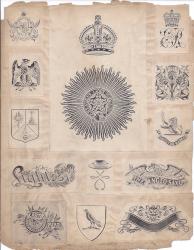
In excess of 500 original engravings, from the professional collection of the draughtsman Arthur F. E. Poley, and mainly done from his detailed illustrations, for advertising and other purposes, including armorial, natural history and other topics.
Poley was awarded the Royal Institute of British Architects Silver Medal for the 'Measured Drawings' which formed the basis of his book on St Paul's Cathedral in London, and his work is notable for its attention to detail. This collection (with very few exceptions his own work) gives a splendid indication of the nature and range of English commercial engraved illustration at the beginning of the twentieth-century. Around 150 loose 'pulls', varying in size from 18.5 x 14.5 cm to 4 x 6 cm. Including trade marks (The Cork Hat Company; Cook's World Travel Service; The Swifan; A. C. Taylor, Corn Merchants; Ayr Wool; High Grade Straw Goods; Tress & Co), crests, badges, vignettes, bookplates, landmarks, engraved title pages (several certainly not by Poley), depictions of sailing ships, war ships, a chauffeur, animals (stags, lions, tigers, horses, cows, fish), advertising (bottles of Roederer and Moet champagne), portraits of kings (George V and George VI). Some of the examples carry instructions and corrections in pencil, and one is dated 1921. A handful of these loose items are creased, but the overall condition is very good, on lightly-aged paper. Also present are around 350 examples, laid down on 27 loose leaves removed from an album. The condition of these items is not as good, with chipping to the leaves also affecting some of them. A similar range of subjects is covered, with the occasional unusual subject (a strongman; nuts and bolts; the backs of playing cards; a smoking gun). Also present are three pencil designs for engraving (including an advertisement for the Westminster Magazine) and a handful of proofs laid down on cardboard, one with directions to the printers, and gilt illustrations cut away from the front boards of a couple of books.


